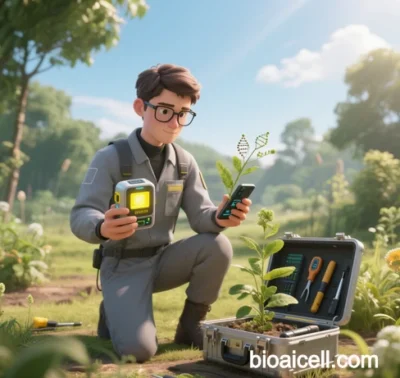
Bio-Cyclic Systems in Agriculture and Organic Production: Practices and Applications
The bio-cyclic system is an agricultural model rooted in natural ecological principles, focusing on simulating material and energy cycles within ecosystems to achieve resource efficiency, environmental sustainability, and closed-loop production. Below is an analysis of its core principles, methodologies, global applications, challenges, and future directions.
I. Core Principles
1. Self-Sustaining Closed-Loop Systems
Bio-cyclic systems integrate farming, livestock, processing, and waste management into a cohesive cycle:
- Composting/Co-composting: Agricultural waste (e.g., straw, manure) is converted into organic fertilizer, replacing synthetic inputs and revitalizing soil health.
- Community-Level Biogas Systems: In Oki Town, Japan, household and school organic waste is transformed into biogas and liquid fertilizer for local crop production, forming a “waste-to-resource” loop.
2. Biodiversity and Ecological Balance
- Biodynamic Agriculture (Germany): Diversified cropping, crop rotation, and biological pest control maintain soil microbiota and beneficial insect populations, reducing reliance on pesticides.
- Agroecological Design (China): Soil microbes and livestock manure synergize with crops to create a “crop-soil-livestock” symbiotic ecosystem.
3. Efficient Energy and Material Flows
- Phosphorus Recovery: Agro-bio cycles reclaim phosphorus from livestock waste, reducing dependence on non-renewable phosphate mines.
- Carbon Sequestration: Biochar technology converts crop residues into stable carbon storage, enhancing soil structure while mitigating climate change.
II. Key Methodologies and Practices
1. Biodynamic Farming
- Philosophy: Rudolf Steiner’s “farm as a living organism” concept aligns agricultural activities with cosmic rhythms (e.g., lunar planting cycles).
- Tools:
- BD500-507 biodynamic preparations (e.g., fermented nettle extracts) to stimulate soil microbial activity.
- Horn manure burial techniques to produce natural fertilizers.
2. Biocyclic-Vegan Agriculture
- Animal-Free Systems: Relies solely on plant-based compost and green manure (e.g., clover) to maintain soil fertility, avoiding antibiotic residues and pathogens.
- Case Study: Germany’s Bio-Modell Walsrode Farm increased soil humus by 30% using plant substrates and biochar, matching conventional organic yields.
3. Smart Ecological Systems
- IoT and Big Data: China’s “Three-Life Smart Agriculture” uses sensors to monitor soil moisture, nutrients, and microbial activity, optimizing irrigation and fertilization.
- Waste Valorization:
- Straw fermentation produces biogas for greenhouses or power generation.
- Aquaculture wastewater is purified through phytoremediation, achieving >80% nitrogen/phosphorus removal.
III. Global Case Studies
| Region/Project | Technological Features | Benefits |
|---|---|---|
| China’s Green Farming Pilot | Crop straw feed + manure composting | Reduced synthetic fertilizers, improved soil health |
| Brazilian Agroforestry | Coffee intercropped with nitrogen-fixing trees | Increased yield, enhanced carbon capture |
| Southeast Asian Rice-Fish | Fish manure fertilizes rice paddies | Lower pesticide use, higher fish yield |
| Japan’s Oki Town Model | Community biogas from food waste | Waste-to-energy, carbon reduction |
IV. Challenges and Solutions
1. Technical and Economic Barriers
- High Initial Costs: Modular systems (e.g., household composters) lower entry barriers.
- Carbon Credit Mechanisms: Monetize ecological benefits to offset investments.
2. Scalability and Standardization
- Regional Adaptation: Customize solutions for arid zones (water optimization) vs. humid regions.
- EU Biocyclic-Vegan Certification: Unified standards for soil health and input restrictions.
3. Awareness and Policy
- Consumer Education: Germany’s “Biodynamic Labels” boost market recognition with 30% price premiums.
- Policy Innovation: India’s Andhra Pradesh trained 100,000 farmers in natural practices within three years.
V. Future Innovations
1. Cross-Disciplinary Integration
- Gene Editing: Develop stress-resistant, low-lignin crops to enhance waste recycling.
- Artificial Photosynthesis: Cyanobacteria-engineered systems for CO2 fixation and energy autonomy.
2. Urban-Rural Synergy
- Vertical Farming + Anaerobic Digestion (Singapore): Convert urban waste into hydroponic nutrients, boosting food self-sufficiency.
3. Climate Resilience
- Arid Zone Water Systems (Israel): Drought-tolerant plants (e.g., cacti) enable 95% wastewater reuse.
Conclusion
Bio-cyclic systems represent a transformative approach to sustainable agriculture, addressing climate change, resource depletion, and biodiversity loss. Their success hinges on technological innovation, policy alignment, and societal engagement. As the FAO states: “Circular agriculture re-embeds humanity within nature’s metabolic networks rather than dominating them.” With advancements in smart technologies and ecological science, bio-cyclic systems are poised to redefine global food production.
Data sourced from publicly available references. For collaborations or domain inquiries, contact: chuanchuan810@gmail.com.






“Bio-Cyclic” 是一个复合术语,其核心含义可从生物学和生态学角度解析如下:
1. 术语构成解析
Bio(生物):指与生命系统相关的要素,如生物圈、生物代谢等。
Cyclic(循环的):描述周期性或闭环过程,如物质循环、能量流动等。
2. 定义与内涵
指生物参与的循环过程,具体可能包含以下维度:
生态循环:如碳、氮等元素在生物圈中的周期性转化(如光合作用与呼吸作用的平衡)。
生理周期:生物体的节律性活动(如昼夜节律、生殖周期)。
技术应用:农业中的轮作系统(Bio-Cyclic-Vegan Agriculture)或废弃物生物降解循环。
3. 应用场景举例
生态研究:分析微生物驱动的有机物分解与再合成过程3。
可持续技术:开发生物燃料的闭环生产系统。